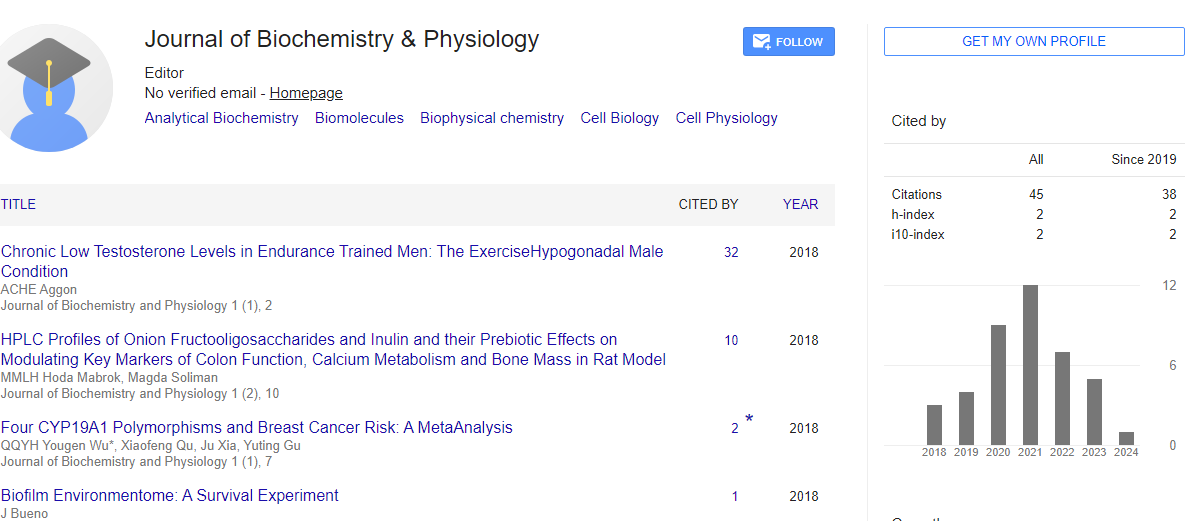Perspective, J Biochem Physiol Vol: 6 Issue: 1
DNA Manipulation Techniques: Tools for Advancement
Qing Huan*
1Department of Chemistry, Hong Kong University of Science and Technology, Clear Water Bay, Hong Kong
*Corresponding Author: Qing Huan
Department of Chemistry, Hong Kong
University of Science and Technology, Clear Water Bay, Hong Kong
E-mail: qinghuan@123.com
Received date: 20-Feb-2023, Manuscript No. JBPY-23-93411;
Editor assigned date: 22-Feb-2023, PreQC No. JBPY-23-93411 (PQ);
Reviewed date: 09-Mar-2023, QC No JBPY-23-93411;
Revised date: 16-Mar-2023, Manuscript No. JBPY-23-93411 (R);
Published date: 23-Mar-2023, DOI: 10.4172/jbpy.1000121
Citation: Huan Q (2023) DNA Manipulation Techniques: Tools for Advancement. J Biochem Physiol 6:1.
Description
DNA manipulation, also known as genetic engineering, involves modifying the genetic code of living organisms. It is a powerful tool that allows developing new organisms and modifying existing ones for various purposes. However, it also raises ethical concerns about the consequences of altering the fundamental building blocks of life. One of the most significant applications of DNA manipulation is in the field of medicine. Genetic engineering can be used to create new treatments for genetic diseases by altering the DNA of affected individuals. This technology has the potential to revolutionize the treatment of genetic disorders. One of the most basic DNA manipulation techniques is Polymerase Chain Reaction (PCR). PCR is used to amplify a specific segment of DNA, allowing scientists to study it more closely. This technique has numerous applications, including the diagnosis of genetic diseases, the identification of pathogens, and the analysis of DNA evidence in criminal investigations.
Another important DNA manipulation technique is DNA sequencing. DNA sequencing is used to determine the order of nucleotides in a DNA molecule. This information can be used to study the function of genes and to identify mutations that cause genetic diseases. Advances in sequencing technology have made it possible to sequence entire genomes, leading to a better understanding of the genetic basis of disease and the development of personalized medicine. CRISPR-Cas9 is a more recent DNA manipulation technique that has revolutionized the field of genetic engineering. It is a powerful tool that allows scientists to edit the DNA of an organism with unprecedented precision. CRISPR-Cas9 works by using a guide RNA to direct a protein called Cas9 to a specific location in the genome. Once there, Cas9 can cut the DNA, allowing scientists to add, delete, or replace specific genes.
The applications of CRISPR-Cas9 are vast and include the development of new treatments for genetic diseases, the developing of genetically modified crops and livestock, and the study of gene function. However, the use of this technology also raises ethical concerns, particularly around the potential for unintended consequences and the creation of genetically modified organisms that could have harmful effects on the environment.
Another application of DNA manipulation is in agriculture. Genetic engineering can be used to develop crops that are resistant to pests and diseases, as well as crops that have higher yields. This has the potential to increase food production and reduce the use of pesticides, which can have harmful effects on the environment. However, the manipulation of DNA also raises ethical concerns. One of the main issues is the potential for unintended consequences. Altering the genetic code of an organism can have unpredictable effects, which could lead to unintended harm. For example, developing crops that are resistant to pests could lead to the evolution of superbugs that are resistant to all forms of pest control. The long-term effects of altering the genetic code of an organism are at risk that unintended consequences could arise. In addition, there is a risk that genetically modified organisms could escape into the environment and cause harm to other organisms. Despite these ethical concerns, DNA manipulation is likely to continue to be a powerful tool in the future. DNA manipulation is a powerful tool that has the potential to revolutionize medicine and agriculture. However, it also raises ethical concerns about unintended consequences, discrimination, and safety. As continue to develop this technology, it is important that carefully consider the ethical implications of actions and proceed with caution.
 Spanish
Spanish  Chinese
Chinese  Russian
Russian  German
German  French
French  Japanese
Japanese  Portuguese
Portuguese  Hindi
Hindi 